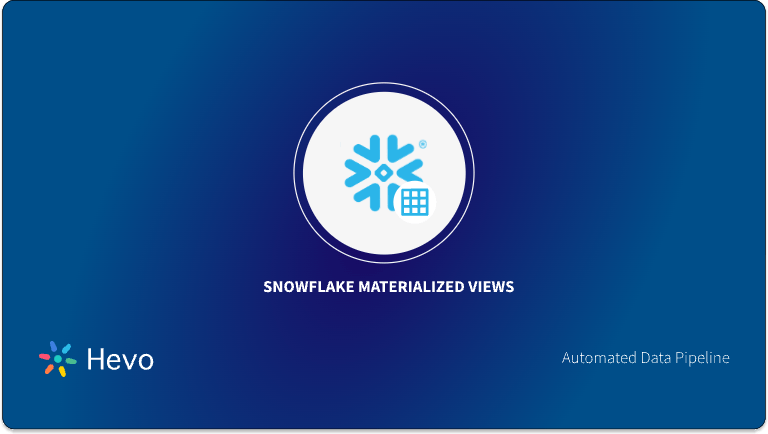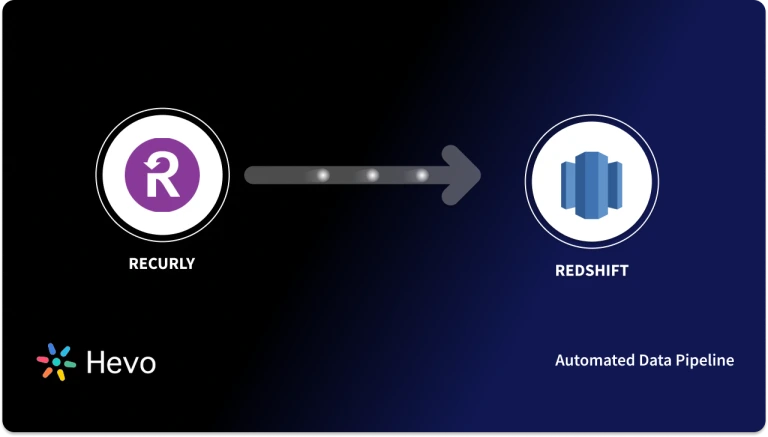Are you struggling to manage subscription data across multiple platforms? You can now seamlessly integrate Recurly and Snowflake for real-time insights and decision-making. In this blog, we’ll walk you through connecting Recurly to Snowflake. You’ll learn:
- All about Recurly and Snowflake
- How to Set Up a Smooth and Reliable Data Pipeline
- The Benefits of Syncing Data from Recurly to Snowflake
Method 1: Automatically Sync your Data from Recurly to Snowflake
Hevo Data simplifies the integration of Recurly with Snowflake by automating the ETL process, allowing for smooth and efficient data migration. This method ensures that billing and subscription data from Recurly is accurately and quickly transferred to Snowflake for in-depth analysis and reporting.
Method 2: Manually Sync your Data from Recurly to Snowflake
Manually transferring data from Recurly to Snowflake offers a tailored approach but requires extensive development and ongoing management. This method can lead to difficulties with adapting to API changes, managing complex data formats, and ensuring reliable and error-free data transfers.
Table of Contents
What is Recurly?
Recurly is a recurring billing platform. It ensures that setups and integrations are easy and quick, and it scales well with the changing needs of the business. Recurly allows businesses to focus on growing their sales as it makes it easy for them to receive payments.
Key Features of Recurly
- Scale Globally: Change is constant when it comes to recurring payments, billing, and customer requirements. Recurly ensures that you are always one step ahead of the competition.
- Adapt Quickly: Simple configuration of trials, plans, pricing, and promotions, as well as support for complex billing scenarios.
- Proactive Thinking: Reduce churn with revenue recovery powered by machine learning, which both prevents and recovers lost revenue from failed transactions.
- Effective Workflow: Integrate workflows without any hiccups by using an enterprise-grade platform.
- Security: Recurly provides you with up-to-date rules, regulations, and compliance standards covering areas such as fraud management and taxes.
What is Snowflake?
Snowflake removes the barriers that bar organizations from extracting actual value from data. Snowflake is a cloud solution for data warehousing, data engineering, data lakes, and data science.
Snowflake provides the scalability, performance, and concurrency that most businesses need while offering a single data experience that covers multiple geographies and clouds.
Key Features of Snowflake
- Snowflake enables you to enhance your Analytics Pipeline by transitioning from nightly Batch Loads to Real-time Data Streams.
- Snowflake uses the Caching Paradigm to deliver the results from the cache swiftly. To avoid re-generating the report when nothing has changed, Snowflake employs Persistent (within the session) Query results.
- Snowflake allows you to analyze Customer Behaviour and Product Usage better.
- Snowflake allows you to create your own Data Exchange, which will enable you to communicate live, controlled data securely.
Prerequisites
This is what you require for integrating your Recurly data with Snowflake:
- A Snowflake Account.
- A Recurly Account.
Method 1: Automatically Sync your Data from Recurly to Snowflake
Hevo provides an Automated No-code Data Pipeline that helps you move your Recurly swiftly to Snowflake. Hevo is fully-managed and completely automates the process of not only loading data from your 150+ data sources(including 60+ free sources)but also enriching the data and transforming it into an analysis-ready form without having to write a single line of code.
Step 1: Configure Recurly
- Configure Recurly as the Source in your Pipeline.
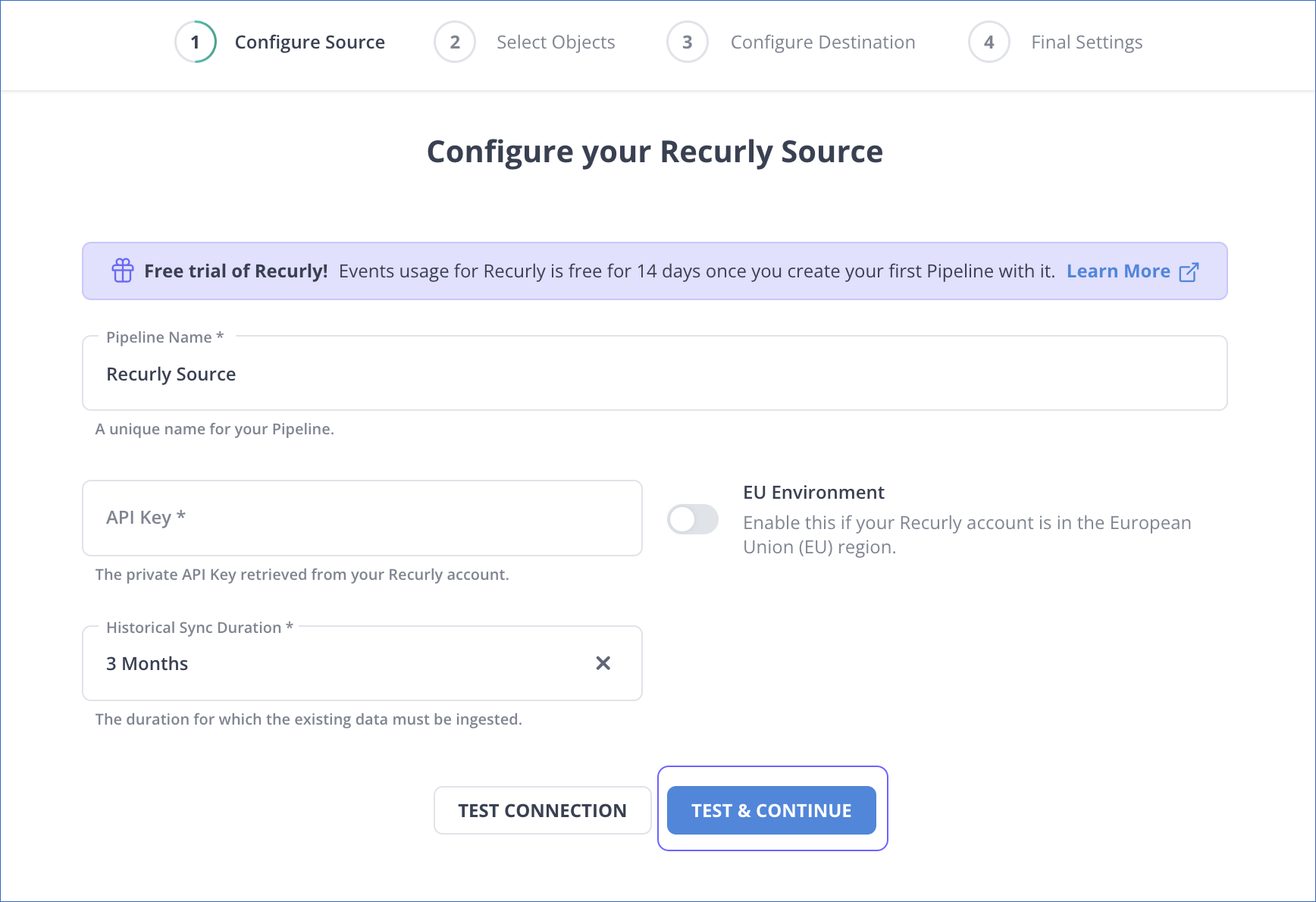
Step 2: Configure Snowflake
- Set up Snowflake as a destination in Hevo.
And you are done! Hevo Data will take care of building the pipeline to replicate data from Recurly to Snowflake based on your inputs while configuring the source and the destination.
The pipeline will automatically replicate new and updated data and provides the option to adjust the data replication frequency as per your requirements.
Data Pipeline Frequency
| Default Pipeline Frequency | Minimum Pipeline Frequency | Maximum Pipeline Frequency | Custom Frequency Range (Hrs) |
| 3 Hrs | 15 Mins | 24 Hrs | 1-24 |
For in-depth knowledge of how a pipeline is built & managed in Hevo Data, you can also visit the official documentation for Recurly as a source and Snowflake as a destination.
Method 2: Manually Sync your Data from Recurly to Snowflake
Recurly uses the Secure Data Sharing framework of Snowflake for the Recurly Snowflake migration of data, meaning that it acts like a Recurly to Snowflake connector. If you are currently a Recurly user, you only have to contact the Recurly account management team and request a data share from the snowflake data marketplace.
- Step 1: Log into your Snowflake account.

- Step 2: Click “Marketplace” from the vertical navigation bar shown on the left.
- Step 3: Type “Recurly” in the search bar shown at the top of the page.

- Step 4: Choose “Recurly platform data-classic.”
- Step 5: Click the “Request” button shown on the right to request the data.
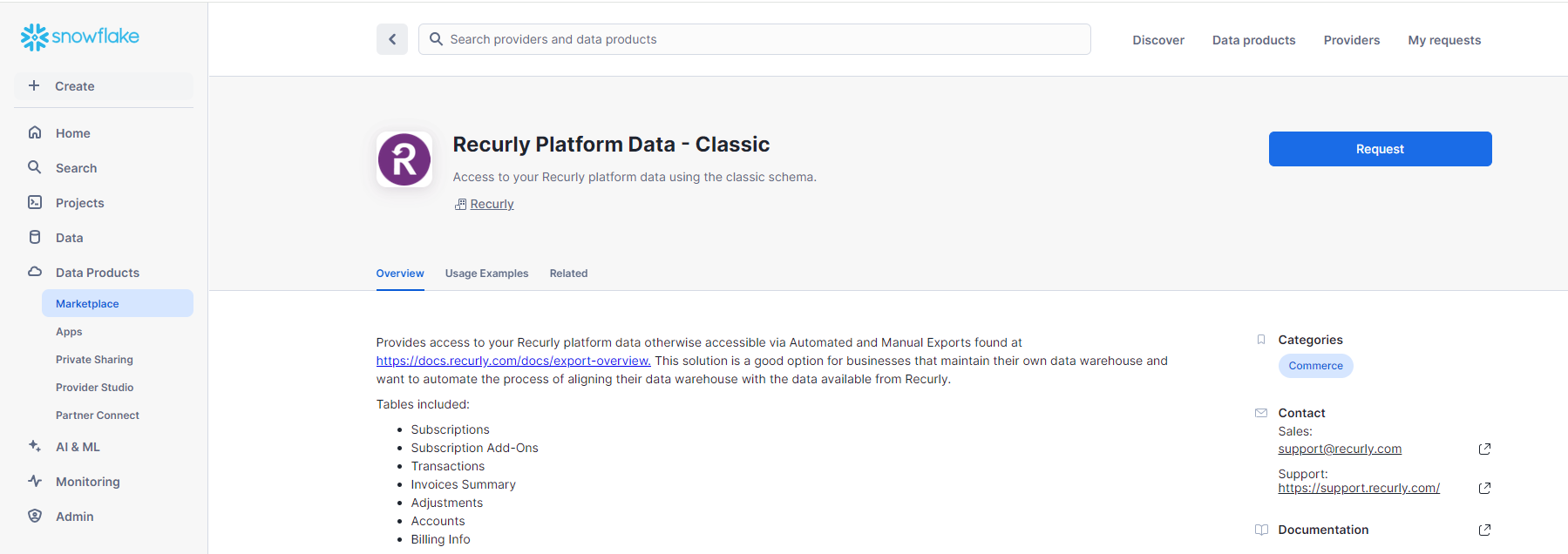
Note: Recurly data is automatically updated in Snowflake after every hour or once a day depending on your desire. This means that the Recurly Snowflake integration will ensure that merchants have up-to-date data all the time.
- Step 6: A new form will pop up. Fill in the required details and click the “Request” button at the bottom to request the data.
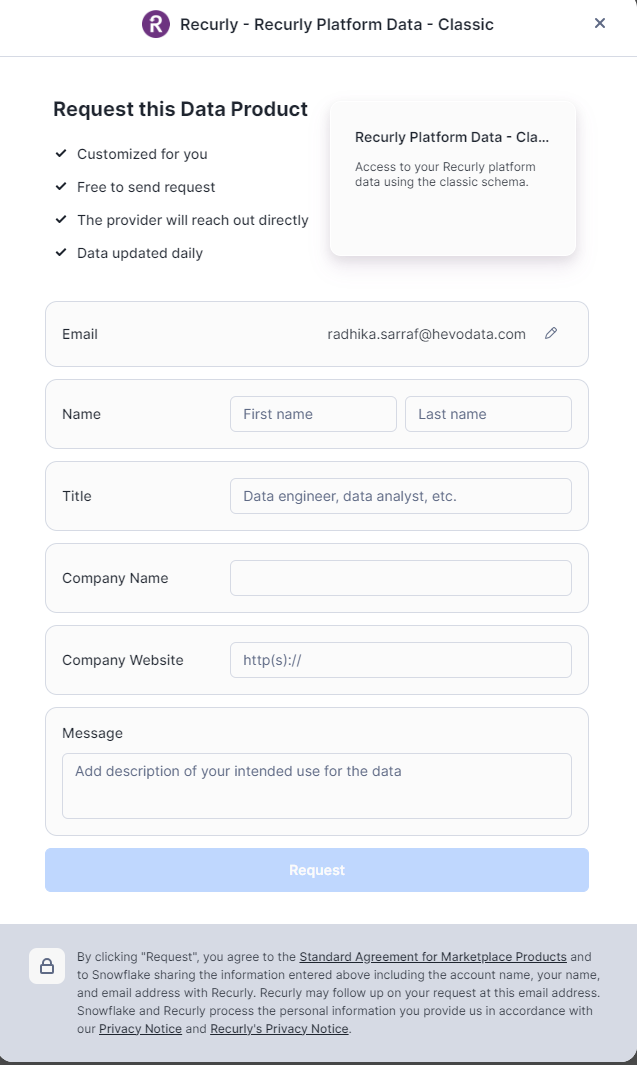
That is how to integrate Recurly to Snowflake. Recurly data is automatically updated in Snowflake after every hour or once a day depending on your desire. This means that the Recurly Snowflake integration will ensure that merchants have up-to-date data all the time.
Why you should Sync Data from Recurly to Snowflake
- A Recurly to Snowflake migration of data is very important for your business. Combining your billing data with other data in Snowflake will unlock many reporting capabilities.
- Having all your data in one place will make it easy to identify business trends. You will also be able to take advantage of Snowflake’s reporting capabilities to generate reports from your data.
- You may also need to create a sales forecasting dashboard using data stored or generated by your CRM and Recurly. These may require you to integrate Recurly to Snowflake.
By migrating your data from Recurly to Snowflake, you will be able to help your business stakeholders find the answers to these questions:
- How does CMRR (Churn Monthly Recurring Revenue) vary by Marketing campaign?
- How much of the Annual Revenue was from In-app purchases?
- Which campaigns have the most support costs involved?
- For which geographies are marketing expenses the most?
- Which campaign is more profitable?
Final Thoughts
- Recurly is a recurrent billing platform. It provides businesses with an easy way to receive payments as they focus on making sales.
- Snowflake is a cloud data warehouse platform. It provides companies with services such as cloud data warehousing, data sharing, data application development, and more.
- A Recurly to Snowflake integration will help you aggregate your billing data with data from other apps and get a holistic view of your business data.
- This is made possible with the help of the Recurly to Snowflake connector provided by Hevo Data.
Hevo allows you to transfer data from 150+ sources (including 60+ Free Sources) such as Recurly and Cloud-based Data Warehouses like Snowflake, Google BigQuery, etc.
Want to take Hevo for a spin? Sign up for a 14-day free trial and experience the feature-rich Hevo suite firsthand. You can also have a look at the unbeatable pricing that will help you choose the right plan for your business needs.
Frequently Asked Questions
1. Which ETL tool is best for snowflakes?
Hevo Data. Hevo is the best tool for performing ETL with Snowflake. It allows you to connect to over 150+ data sources.
2. How do I migrate to Snowflake?
1. Analyze The Data. The first step in Snowflake data migration warehouse migration is
analyzing the data.
2. Choose a Migration Method.
3. Select & Split Data.
4. Stage The Data.
5. Auto-Compress Files.
6. Implementation.
7. Verify Cloud Migration.
3. Can Purview connect to Snowflake?
Yes, Microsoft Purview can connect to Snowflake to catalog, classify, and manage Snowflake data for governance and compliance purposes.






